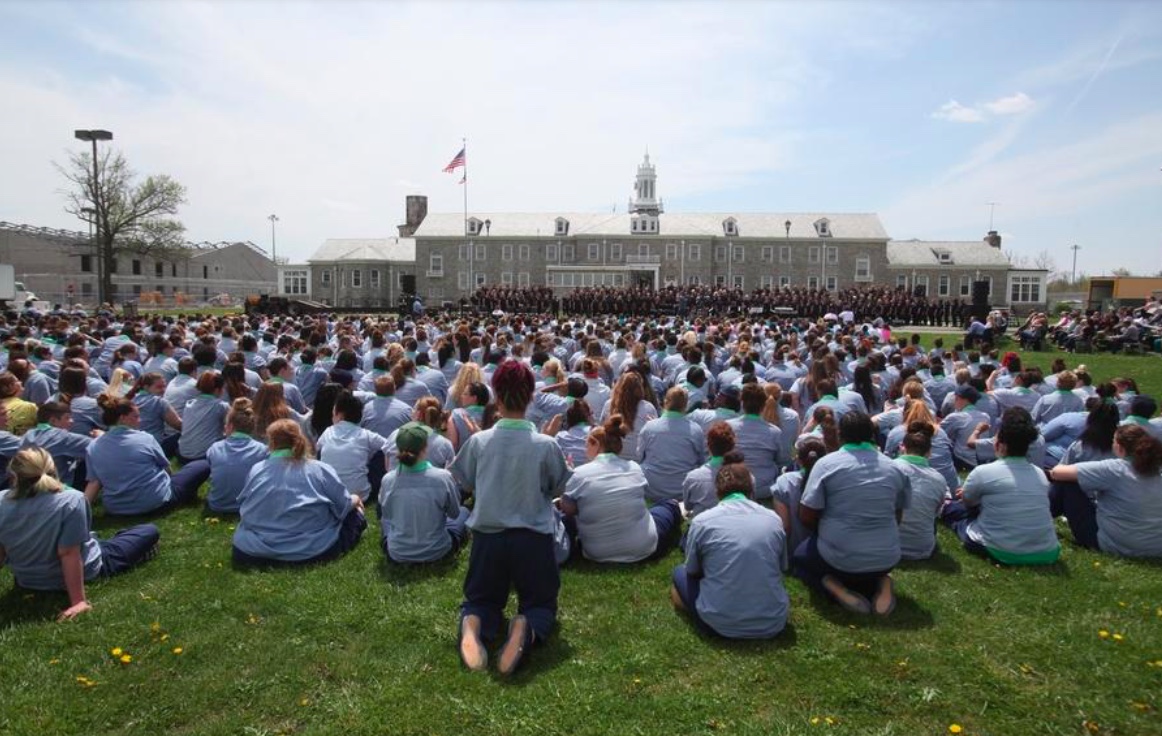With pastel tee shirts pulled over prison scrubs, 100 incarcerated women stand side-by-side in the prison courtyard swaying in unison on makeshift risers, belting out the lyrics to Kesha songs.
When the sharpest words wanna cut me down
I’m gonna send a flood, gonna drown them out
I am brave, I am bruised
I am who I’m meant to be, this is me
The bright Spring sun peeks out from behind the stone walls of Ohio’s oldest prison. I sit mesmerized as the choir members of the Ohio Reformatory for Women serenade their fans — an audience of over 1000 incarcerated women sitting cross-legged in neat rows on the freshly cut lawn. This eager ensemble is known as Inside/Out. They are led by David Brown and ORW warden, Ronette Burkes, in conjunction with the Harmony Project.
The crowd cheers and sings along. They make hand-heart gestures high above their heads to show support. I am transported. I lose track of time.
Of course these women rarely lose track of time. They don’t have that luxury. They are constantly reminded of the mistakes they’ve made — some more egregious than others — as they count down the months or years they serve until given another chance. But occasionally they are transported — at least outside of their minds. That is what’s happening today. With the warm sun and the cool breeze. The four-piece band and the standing ovations.
But I won’t let them break me down to dust
I know that there’s a place for us
For we are glorious
The number of women serving time in Ohio prisons is rising. Last year, over 3,000 women were imprisoned statewide. Some of these crimes are addiction related, such as trafficking, and others (like burglary) are committed to support a habit. In response, health officials and community organizers are looking for ways to help women, to keep them out of prison and away from the pressures that keep them returning.
Another round of bullets hits my skin
Well, fire away ’cause today, I won’t let the shame sink in
A reminder of this challenge, and a symbol of hope, provides the backdrop for today’s performance. Sitting stage left behind the choir is a partially constructed concrete and steel building — a nursery. The ORW is one of four prisons in the country that allow children and infants to stay with their mothers while incarcerated. Pregnant women convicted of nonviolent offenses, serving less than three years, can keep their babies with them while serving their sentences. They live and sleep together as a family. They eat as a family. They play as a family. They solve problems. They bandaid booboos. In learning how to parent, these women also learn how to care for themselves. Not unlike the rest of us.
Look out ’cause here I come
And I’m marching on to the beat I drum
I’m not scared to be seen
I make no apologies, this is me
While the goal is to keep families together, there is also something bigger at work here. The women at ORW strive to close the mother-child gap by participating in the prison’s Tapestry program. This therapeutic community enables women with substance addictions to live and work together to develop the skills needed to remain drug and crime-free. The program has many remarkable features but its work with Sunflower House, a South African hospice, may be its most impressive. Through monthly Skype calls, the women connect with terminally ill children, many of whom are separated from their own mothers. The women read to the children and perform puppet shows. They knit socks and send handmade gifts. Mamas who are longing for their own babies sing lullabies to other babies. And these babies need all the love they can get.
I’m proud of who I am
No more monsters, I can breathe again
And you said that I was done
Well, you were wrong and now the best is yet to come
No doubt, the problems with our prison system are legion. It will take a lot more than music and mothering to move us in the right direction. But for one sunny afternoon, these women aren’t prisoners. They’re not even mothers or daughters. Not wives, nor sisters. They are performers and they are rocking the house.


